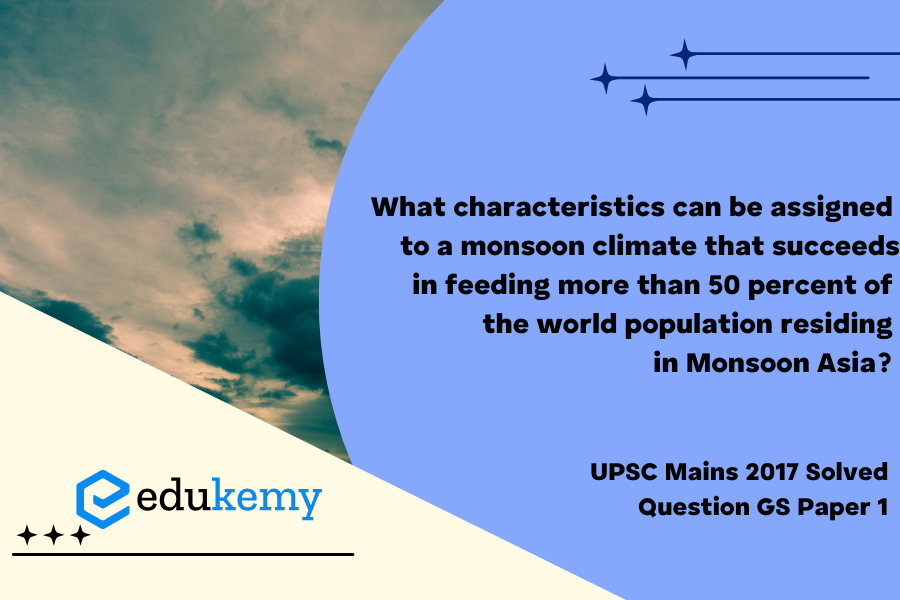The monsoon climate, characterized by seasonal shifts in wind patterns and heavy rainfall, plays a pivotal role in sustaining life across Monsoon Asia, a region that is home to more than 50 percent of the world’s population. Several distinctive characteristics contribute to the success of this climate in supporting the livelihoods of millions. One key feature is the well-defined wet and dry seasons, crucial for agriculture and food production. The monsoon brings abundant rainfall during the wet season, allowing for the cultivation of a variety of crops that form the backbone of the region’s agrarian economy. The predictable onset of the monsoon is another critical factor, enabling farmers to plan and prepare for the planting season with confidence. Moreover, the fertile soils in Monsoon Asia benefit from the replenishing effects of the seasonal rains, fostering robust agricultural ecosystems.
Tag: Geography.
Contents
Decoding the Question:
- In Introduction, try to start by defining monsoon.
- In Body,
- Discuss various characteristics of monsoon.
- In Conclusion, try to write about the overall significance of the monsoon.
Answer:
Some parts of the world experience seasonal winds like land and sea breezes but do so, on a much larger scale. There are tropical monsoon lands with on-shore wet monsoons in the summer and off-shore dry monsoons in the winter. A monsoon is a seasonal change in the direction of the prevailing, or strongest, winds of a region. Monsoons cause wet and dry seasons throughout much of the tropics. Monsoons are most often associated with the Indian Ocean.

Characteristics of the Northeast Indian Monsoon :
- Timing and Duration: The Northeast Indian Monsoon typically begins around June and lasts until September. It brings a significant portion of the annual rainfall to the region during this period.
- Rainfall Amount: The northeastern states of India receive substantial rainfall during the monsoon season. For example, Assam and Meghalaya receive an average annual rainfall of around 2,500 to 3,000 millimetres, while Arunachal Pradesh receives even higher rainfall, ranging from 3,000 to 4,000 millimetres.
- Onset and Withdrawal: The onset of the monsoon in the northeast is usually around the first week of June, and the withdrawal occurs in September. The timing of the monsoon onset and withdrawal can vary from year to year.
- Impact on Agriculture: The monsoon rains are crucial for agriculture in the region. They support the cultivation of various crops, such as rice, tea, jute, and spices. The agricultural economy of the northeast heavily depends on the monsoon rainfall.
- Topography: The northeastern states have diverse topography, including hilly terrain and valleys. The hilly regions experience orographic rainfall, where the moist monsoon winds are forced to rise over the mountains, leading to increased rainfall on windward slopes.
- Multiple Peaks in Rainfall: The Northeast Indian Monsoon exhibits multiple peaks in rainfall during the season. There are typically two peaks, one in June and the other in September, with a relative lull in July and August.

Characteristics of the Southwest Indian Monsoon :
- Timing and Duration: The Southwest Indian Monsoon typically arrives in India around the end of May or early June and lasts until September. It is the primary monsoon season that brings the majority of the country’s annual rainfall.
- Rainfall Amount: The southwest monsoon is responsible for the majority of India’s rainfall. On average, it accounts for about 70-80% of the country’s total annual precipitation.
- Onset and Progression: The monsoon onset is marked by the arrival of the southwest monsoon winds over the southern tip of India (Kerala). From there, the monsoon progresses northwards, covering the entire country in a span of a few weeks.
- Regional Variation: The southwest monsoon exhibits regional variations in terms of its timing and intensity. Coastal regions and the Western Ghats receive heavy rainfall, while areas in the rain shadow of the Western Ghats, like parts of Tamil Nadu and Karnataka, experience lower rainfall.
- Impact on Agriculture: The southwest monsoon is crucial for Indian agriculture, as it waters the Kharif crops (summer crops) such as rice, cotton, sugarcane, and pulses. These crops are grown during the monsoon season and depend on its timely and adequate rainfall.
- Variability and El Niño: The southwest monsoon exhibits interannual variability. El Niño and La Niña events in the Pacific Ocean can influence the monsoon’s behaviour, leading to droughts or excessive rainfall in different parts of India.
Conclusion:
The role of monsoon is vital in the economy of major parts of the world because it is the main source of irrigation in rain-fed areas and facilitates in feeding more than 50 percent of the world population residing in Monsoon Asia.. About 64 per cent of India’s people depend on agriculture for their livelihood, and agriculture itself is based on the southwest monsoon.
In case you still have your doubts, contact us on 9811333901.
For UPSC Prelims Resources, Click here
For Daily Updates and Study Material:
Join our Telegram Channel – Edukemy for IAS
- 1. Learn through Videos – here
- 2. Be Exam Ready by Practicing Daily MCQs – here
- 3. Daily Newsletter – Get all your Current Affairs Covered – here
- 4. Mains Answer Writing Practice – here


